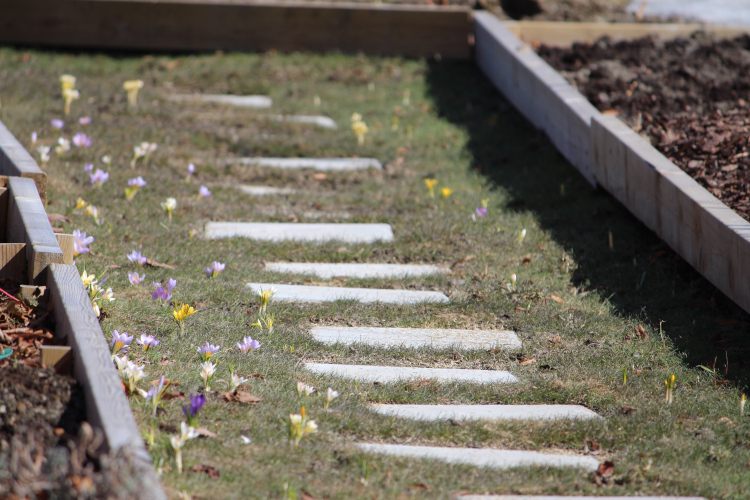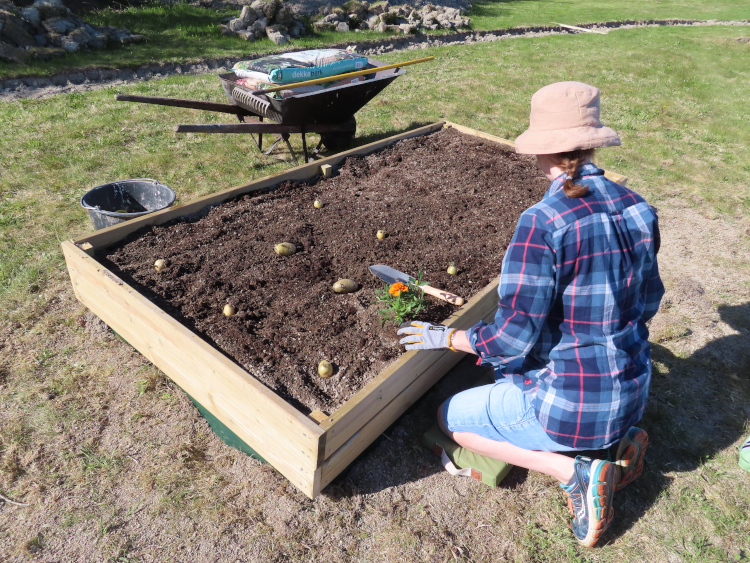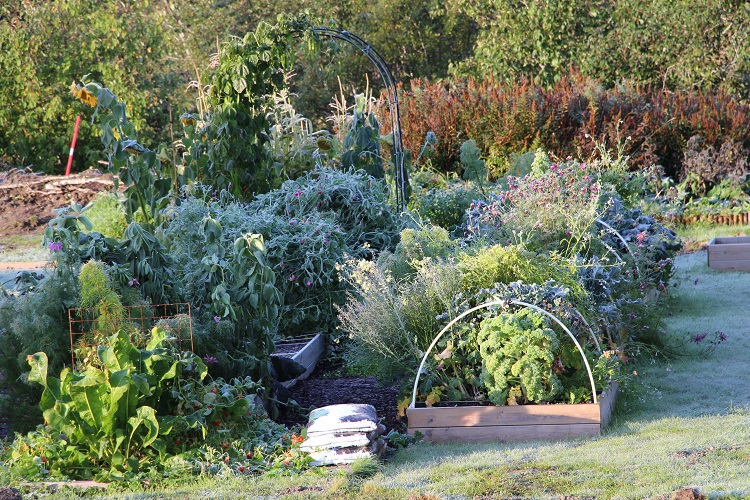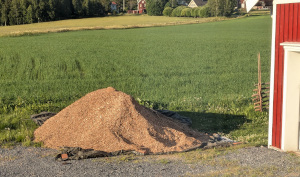Gardening in Northern Sweden
This article is for people wondering what it is like growing vegetables in northern Sweden, compared to places like the UK. Specifically for location and climate, we’re a little south of Umeå and near the sea. We aren’t experts, we’re just having fun learning as we go.
The Seasons
Not much happens prior to April as there is deep snow cover and permafrost, although the temperature is rapidly warming and the snow is melting more each day. Plants are already being prepared indoors and later in the greenhouse but the timing can be tricky. If the plants live too long indoors they become long and weak and will die if place outside in the wind. So we take things in steps, move the plants from the house, to a plastic box in the greenhouse, then unprotected inside the greenhouse. In May they will move to the outside.

The last frost is approximately in week1 of May, which feels late. Through May is a good time to be repairing raised beds and building anything new. Most trees bloom in the last week and it is important to clear cocooning bugs from the smaller apple trees.

June is marked by long hours of daylight, intense sunlight and heat, and wind. Plants can really suffer in June without some protection. Mosquitos and horseflys make watering in the evenings a pain so it requires a facenet and loose-fitting clothing. Aphids start to attack any struggling plants. Black wind netting of the white fly mesh seems to work really well at keeping pests off and reducing the effects of strong sun and wind, plus the rain can go right through the meshes so there is less water requirement unlike fine fleece.

July things get easier. There’s more likely to be rain, and sunny days are mixed with cloudy ones, so the plants have an easier time. We’re picking lots of vegetables during this time. The strawberries ripen. In the last weeks of July the blueberries ripen. Slugs are a big problem for us in July.

August can be wet and is starting to be noticeably darker. We start to harvest.

September is the last month, and any final harvesting happens. Tools and equipment need to be put away before winter. The first light frosts hit in week 2-3 and start killing off parts of unharvested plants.

October, temperatures drop below zero, the first snow comes. The soil starts to freeze and no more growing is possible.
November is the last chance to tidy up any garden projects and move any equipment to or front the greenhouse as the frost will stick things to the ground and heavy snow will come soon.
Types of Plant That We Normally Grow
Most people locally seem to grow potatoes, tomatoes, gherkins, and strawberries plus other things.
If I was starting from scratch I’d start with planting Potatoes because they do so well here. They are quite robust, recovering well from imperfect planting conditions or, with a little water, recovering from wilting if they dont get enough water on a sunny day. The dense leaves also shade out the weeds and reduce the work needed to grow them. It is possible to build up a big reserve of potatoes before winter with not much land and eat the potatoes all through winter up to April. We tend to grow them in large builders mixing pots with a bag of compost because they were getting some kind of larvae eating tiny holes in them in the raised beds.

Tomatoes work great in the greenhouse but sometimes have a rough time in the wind and relentless sun outside. We grow some, and my partner likes them but I find the other plants more interesting.
A couple of plants in the greenhouse gives us too many gherkins from mid july onwards. They dont keep like a potato and I think everyone has too many at the same time because it is hard to even give them away but they taste great. We might have to get into pickling to make the most of them.
Strawberries do great and respond well to a bit of removing competing weeds. Strawberries will need some kind of netting to stop crows and magpies eating them all.

Chives also do great and we now plant them around all the fruit trees to see if the smell from the chives can reduce pests finding the trees. I like putting some chive seeds in random places and seeing them pop up weeks later.

With a bit of weeding, artichokes seem unstoppable once they get going and spread out of their raised bed. Onions seem to do great with good compost soil although it struggles in the standard clay-type soil otherwise and the magpies sometime pull up the smaller onions.
Although we’ve planted some american blueberry bushes that were zones correctly the initial winter winds before the snow comes can be tough on the bushes and can kill branches back to the roots. Our aim is to add wind shelter near the bushes and in the long term we will encourage the native blueberries next to the american ones to give them some companion support from the elements. You know the local varieties will always survive winter. Gooseberry bushes seem tough and unfazed by winter.
The full list that I can think of:
- Apple trees
- Aubergines
- Black and red currents
- Blueberry bushes
- Brocholli
- Brussel Sprouts
- Cabbage
- Chives
- Courgette / Zucchini
- Garlic
- Gooseberries
- Kale
- Jerusalem artichokes
- Onions
- Plums
- Potatoes, early and late crops
- Raspberries
- Strawberries
- Sweet potatoes
- Tomatoes (in greenhouse)
Growing Problems
The two main problems relate to the season length and plant zoning for winter survival.
As an example of season length issues, Sweetcorn is tricky to finish in time. It needs every single day of the growing season in order to be ready in time before the first frost, and also needs great soil, fertiliser, and consistent watering. We grow it mainly because two separate people told us it would be impossible, and so we now must grow it to prove them wrong. We are very stubborn.
I’ve already mentioned zoning indirectly in the section above but its an important consideration. Plants intended for a warmer growing zone can be planted but in spring will likely have had all branches killed, down to the height of the winter snowcover. Even a plant being of the correct zone wont stop such damage however. In last winter (Dec 2023), an especially cold (-30C) early winter with high winds blew away the small amount of snow cover for many of our blueberry bushes. As a result they spent the next spring and summer recovering with the higher parts of the bushes dried and dead. We could have put fleece on them but the strong winds catching the fleece would have risked snapping the plants.

Our tactic for the next winter was to create more wind reduction in the garden with strategic features that let the wind through but slow it down. I think something like straw bales near the plants would also be great, if you had them available, as it would give some protection from wind whilst supporting its own weight and not changing shape before the snow became established.
Garden Pests
The main pests we have are slugs on the vegetables, and caterpillars on the fruit trees. Greenfly are present but mostly target plants and trees that have had a bad winter or are suffering for other reasons. So it’s a good idea to treat the greenfly but also a great idea to find and treat any underlying cause.
Although it doesn’t stop them, slugs dont seem to like crossing our gravel paths so much, so if I were to design a garden from scratch I’d likely border it with a gravel path (which would also be useful for access and drainage). Keeping any grass and border areas cut back and removing places to hide also seems to help. There are a lot of myths about slugs (copper strips, sharp edges etc). A hand picking session in the evening with a bucket is good, I think a chicken with a protected perimeter patrol route would be better but we dont have one yet.

Caterpillars seem to go for the fruit trees in June. So we walk around them now and then to look for leaves that have been sewn shut with silk, and then use a knife to open them up and remove the caterpillars that is inside and eating the leaf from the inside out.
Magpies, crows and ravens will pick strawberry plants clean and dig up garlic. Some light netting and fake strawberries made of Fimo clay seem to have worked.
Similar to the UK, cats wander outdoors and tomcats will spray bushes and similar, so don’t eat raspberries and similar without washing them.
Watering
Watering is the main problem in mid summer. Not only the amount of watering needed during the summer but also the opportunity for watering is more limited. Watering plants during the day in full sunlight causes problems; it’s much better for the soil to be wet and the leaves to be dry.
If you have a stream you’re allowed to extract water for irrigation, up to a specific limit (I think it is 10m3 a day, which is plenty for a half acre). Depending on your area, the stream might not be clean however so it’s better to use this water for soil water (e.g. the base of trees and bushes, not sprayed onto the leaves of vegetables). Specifically in rural areas, peoples septic cistern systems may discharge into the stream. The plants do seem to do better with stream water compared to tap water.
Inputs
The local shops sometimes have deals on bags of garden compost, especially in the spring, but it is expensive and doesn’t feel especially sustainable to buy lots of plastic bags. We can get pallet deliveries which are really useful to have just as the snow is melting. But the weight and distance causes the postage cost to be high.
It’s possible to get manure deliveries from local horse owners although you may be in competition with others and the manure might be a bit raw. For example there might be rocks in it and large beetle larvae, which isn’t a significant problem but just something to account for as you process it.
Compost heaps are ok but depend on your ability to wait for theme to start producing, and your time available to turn them over. You will produce compost quicker if you turn them, but If it takes you an entire day and you could have worked that day, then someone elses compost might have been cheaper to purchase and not risked a back injury. They reduce loss of material from the garden but its not a true input of material so we were keen to find other sources.

We made our compost heaps from pallets. These aren’t free. Euro pallets (epallar) have a deposit on them so we get charged roughly €5-10 for each pallet. It takes 4 pallets for a bay of almost 1m3. Developing half an acre will fill 3-4 a year before it reduces down over time. We also have two cheap plastic compost bins that winter kitchen waste goes in since the compost heaps will be deep under snow and the crows will spread the kitchen waste around the garden otherwise. If we were starting from scratch I think we might have 8 bays for half an acre and if I had the time I’d rotate them regularly to produce a compost output sooner.
Around by us there is a lot of timber processing and someone who sells chipped trees (felled trees that could not be used for timber production) for burning was happy to sell us woodchip for the garden. It is fantastic for paths and we can get it delivered in large amounts. After a few years on paths we can replace it and compost the older woodchip. This gave us an input that will improve the garden and soil over time.

Using a Greenhouse
The greenhouse doesn’t solve all problems but starts the growing season sooner and extends the growing season significantly for the plants inside. A small greenhouse oil heater can help in late April or early May to keep the temperature above zero during overnight temperature drops. The rest of the year it is important not to overfill it as it causes ventilation, bug, and fungus problems.

Because of the large season shifts compared to the UK, there isn’t much to gain from thicker polycarbonate sheets and triple cell designs. Essentially once it goes below zero it is also dark, and heading consistently towards -10C, then -20C and then colder. There is no occasional warm sunny day to make the greenhouse warm again. If you do need to grow something, the basement of the house or the garage will be warmer.

I built our greenhouse slightly below ground to try and keep the temperature more consistent. This also causes water ingress issues in the spring as the snow melts but we have a pump out point which we use for about 7-10 days. I hope to automate this with a much smaller 12v bilge pump but for now we use a large sump pump and turn it on as needed.

Breaking the Rules
We do the following things that would annoy the Internet purists
We sometimes purchase commercial fertiliser. It’s partly due to time and partly community. If we’re try to get a new bush or tree establishes, or recovered from winter damage, then we’ll give it some liquid fertiliser occasionally to try and get it as healthy as possible before the freezing weather hits in October. It also gives me us an excuse to visit the local hardware store and buy something small in order to say hello, so that they’ll hopefully remember us when we need something in a panic in winter.
We sometimes buy bagged compost. It is inexpensive compared to the time managing the compost heaps, and super helpful to have at the start of spring in the greenhouse.
If we express an interest in growing a plant but someone speaks in absolute terms saying that it is impossible, then we are going to go and grow that impossible plant. We were told roses would never grow. Our roses are doing great. We were told sweetcorn was impossible, we’re in year two of attempting to get a sweetcorn crop. I don’t think we’ll manage it this year as the last winter was longer than normal but I think we have learnt enough to manage it next year.
We use woodchip around plants which many people say will stunt the plants. We dont layer the woodchip too deep and we add compost underneath to offset any nitrogen absorption by the woodchip. In general we find the weed control and soil moisture protection of the wood chip layer is worth any extra plant maintenance needed.

